11th Century Ammapalli Temple of Sri Seetha Rama
Ammapalli Temple, also known as Sri Sita Ramachandra Swamy Devasthanam, is a magnificent Hindu temple dedicated to Lord Rama, Sita, and Lakshmana. Located in Shamshabad, Hyderabad, Telangana, India, it’s a revered site for devotees and a stunning example of Chalukya architecture.
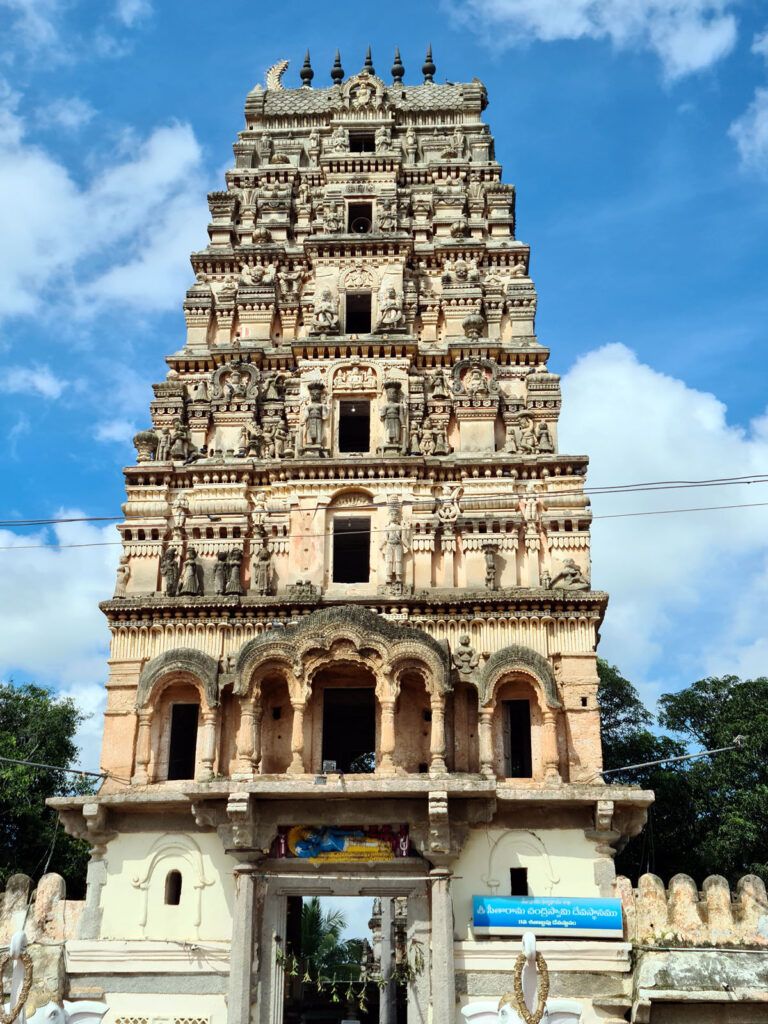
Contents
- 1 History of Ammapalli Temple:
- 2 Legend of Ammapalli Temple:
- 3 Myths of Ammapalli Temple:
- 4 Architecture of Ammapalli Temple:
- 5 Ammapalli Temple Timing and Rituals:
- 6 Festivals of Ammapalli Temple:
- 7 Places to visit near Ammapalli Temple:
- 8 Ammapalli Temple Wedding Cost:
- 9 Ammapalli Temple FAQ:
- 10 How to reach Ammapalli Temple:
- 11 Google Maps:
History of Ammapalli Temple:
Age and Origins:
- Construction: Estimates vary, but most sources point to the 11th or 13th century.
- Builders: The Vengi Chalukyas, a powerful dynasty that ruled parts of South India.
- Significance: One of the oldest and most revered temples dedicated to Lord Rama in the region.
Unique Features:
- Monolithic Idol: The central deity, Kodandarama, is carved from a single stone, showcasing exceptional craftsmanship.
- Unusual Depiction: Lord Rama holds an arrow in his right hand, unlike most temples where he’s shown with a bow.
- Absence of Hanuman: Unlike many Rama temples, Hanuman is not present in the sanctum sanctorum, making Ammapalli a rare exception.
Evolution and Significance:
- Growth over Time: The Ammapalli temple complex has expanded over centuries, now spanning 250 acres with two large temple tanks and other shrines.
- Cultural Hub: Ammapalli has served as a center of religious and cultural activity for centuries, drawing devotees and tourists alike.
- Modern Recognition: The temple’s historical and architectural importance have led to its recognition by the Archaeological Survey of India.
Additional Points:
- Some sources claim the central idol could be even older than the temple itself, possibly dating back a thousand years.
- The Ammapalli has gained popularity in recent years, attracting film shoots and other media attention.
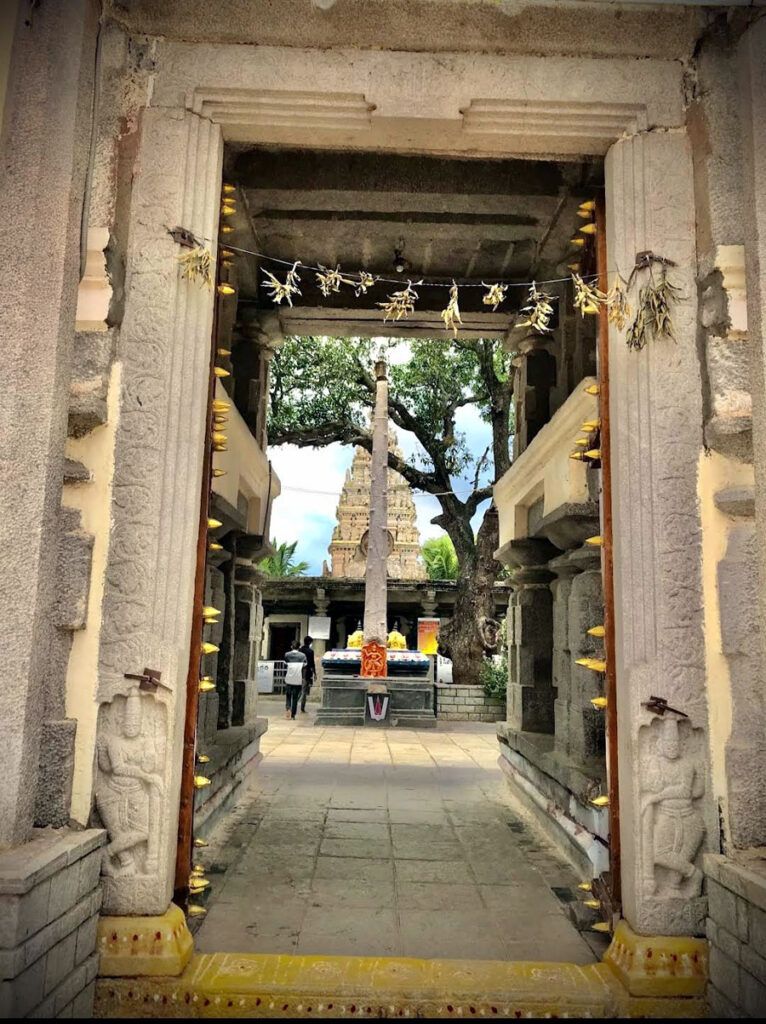
Legend of Ammapalli Temple:
1. The Dream and the Devotee:
Legend has it that a humble woman named Amma lived in the village centuries ago. One night, Lord Vishnu appeared to her in a dream, revealing a hidden idol buried deep within the earth. He instructed her to build a temple on that very spot to house the sacred figure. Amma, filled with divine faith, embarked on this monumental task, facing ridicule and disbelief from the villagers. But her unwavering devotion fueled her actions.
With tireless efforts, Amma unearthed the idol, a magnificent monolithic carving of Lord Rama, Sita, and Lakshmana. As the temple rose around it, the villagers, witnessing Amma’s unwavering spirit and the divine beauty of the idol, finally embraced her vision. The temple, thus, became a testament to the power of faith and the unwavering spirit of a single devotee.
2. The Unique Absence of Hanuman:
Unlike most Rama temples, the Ammapalli sanctum sanctorum houses only the idols of Rama, Sita, and Lakshmana. Notably absent is the loyal Hanuman, who typically stands by Rama’s side. This apparent anomaly has sparked several interpretations:
- Some believe that Rama and Lakshmana reached the temple site before Hanuman’s arrival, explaining his absence.
- Others suggest that Hanuman is present in spirit, guiding devotees from outside the temple.
- A more poetic explanation posits that Hanuman’s devotion is so immense that he doesn’t need a physical form to be present.
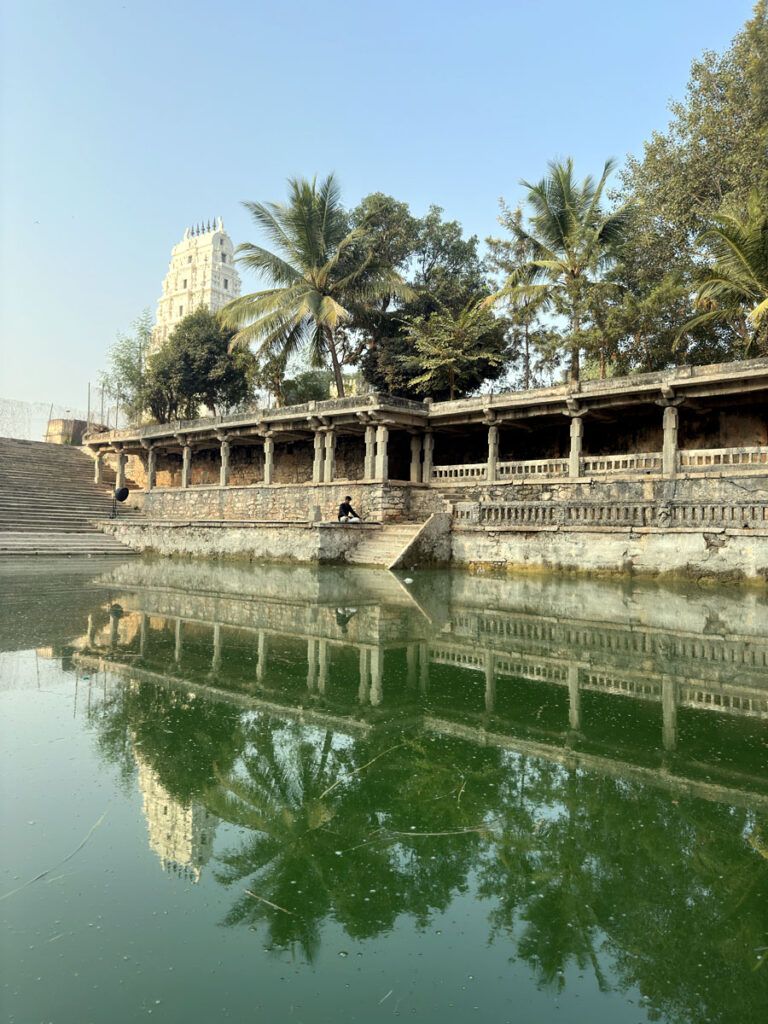
Myths of Ammapalli Temple:
1. The Dream of Amma: According to the most popular legend, a devotee named Amma dreamt of Lord Vishnu himself. In the dream, the divine figure instructed Amma to build a temple on the very spot where she stood. Upon waking, Amma found a divine footprint imprinted on the ground, further solidifying her faith. This footprint is still revered today and can be seen within the Ammapalli complex.
2. The Churning of the Ocean of Milk: Another captivating myth links Ammapalli to the celestial event known as Samudra Manthan, the churning of the cosmic ocean. It is believed that the celestial nectar, Amrita, spilled onto the earth at seven locations, and Ammapalli is said to be one of those blessed spots. This association imbues the temple with an aura of divine bounty and immortality.
3. The Divine Abode of Nara Narayana: Some versions of the myth associate Ammapalli with Nara and Narayana, two incarnations of Lord Vishnu. It is said that they resided here, meditating and guiding devotees on the path of spiritual enlightenment. This belief adds to the temple’s reputation as a sacred space for spiritual seekers.
4. The Hidden Treasure: A more playful myth speaks of a hidden treasure within the temple complex. Legends claim that a pot filled with gold lies buried beneath the Ammapalli temple grounds, waiting to be discovered by a worthy soul. This adds a touch of intrigue and mystery to the temple’s atmosphere.
5. The Temple’s Miraculous Powers: Devotees often recount stories of the temple’s miraculous powers. They believe that prayers offered here are readily answered, and wishes granted with divine grace. This unwavering faith in the temple’s power continues to draw pilgrims from far and wide.
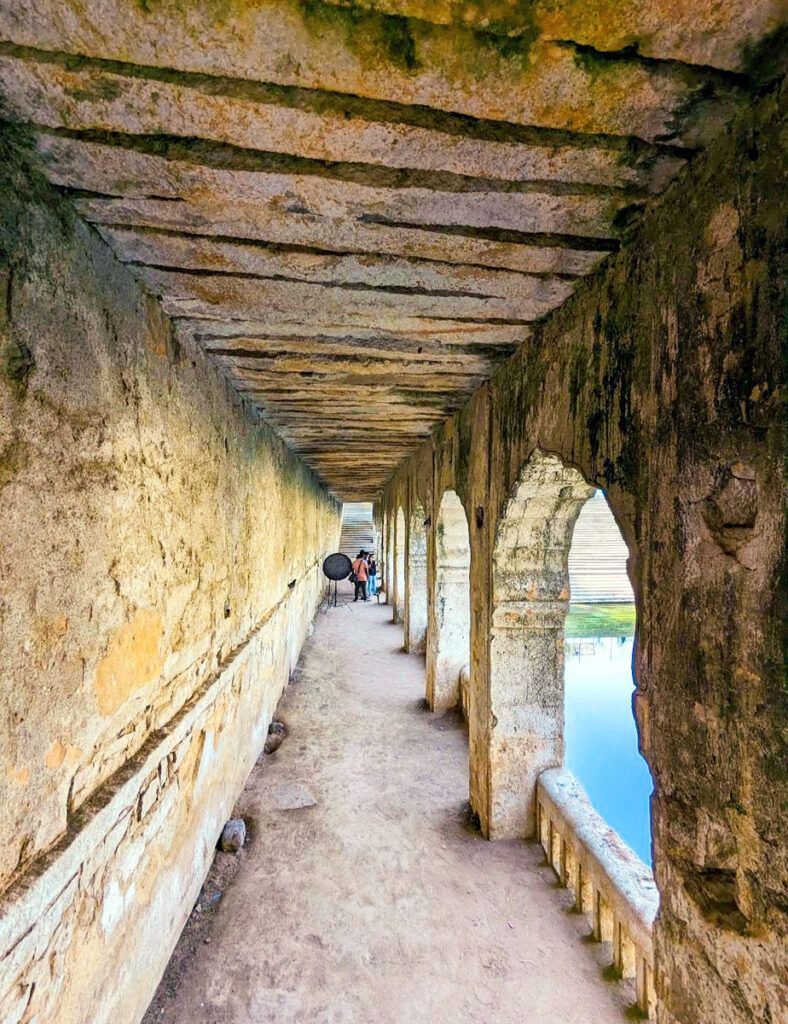
Architecture of Ammapalli Temple:
The Ammapalli Temple boasts a fascinating blend of architectural styles, showcasing its rich history and evolution over centuries. Here’s a breakdown of its key architectural features:
Dravidian Style:
- Gopuram: The most striking element is the towering seven-story gopuram, adorned with intricate carvings and sculptures. Its pyramidal shape with receding tiers is a hallmark of Dravidian temple architecture.
- Mandapams: The temple complex features several pillared halls or mandapams, providing spaces for rituals and gatherings. These mandapams typically have intricately carved pillars and ceilings.
- Sculptures: The temple walls and gopuram are adorned with numerous sculptures depicting various deities, mythical figures, and scenes from Hindu mythology. These sculptures add a layer of visual storytelling to the temple’s narrative.
Nagara Style:
- Sanctum Sanctorum: The inner sanctum where the main deity resides is built in the Nagara style, characterized by its square base and shikhara (tower) rising above. This style is often seen in North Indian temples.
Unique Elements:
- Makara Thoranam: The entrance archway is carved from a single black rock and features a “makara thoranam,” an arch adorned with mythical makara creatures.
- Vishnu Idol: A large sleeping Vishnu idol is carved on the gopuram, adding a unique touch to the Ammapalli temple’s iconography.
Rajasthani Influences:
- Gopuram Design: Interestingly, the first tier of the gopuram exhibits elements of Rajasthani architecture, particularly in its flared chajjas (cornices). This fusion of styles showcases the temple’s cross-cultural influences.
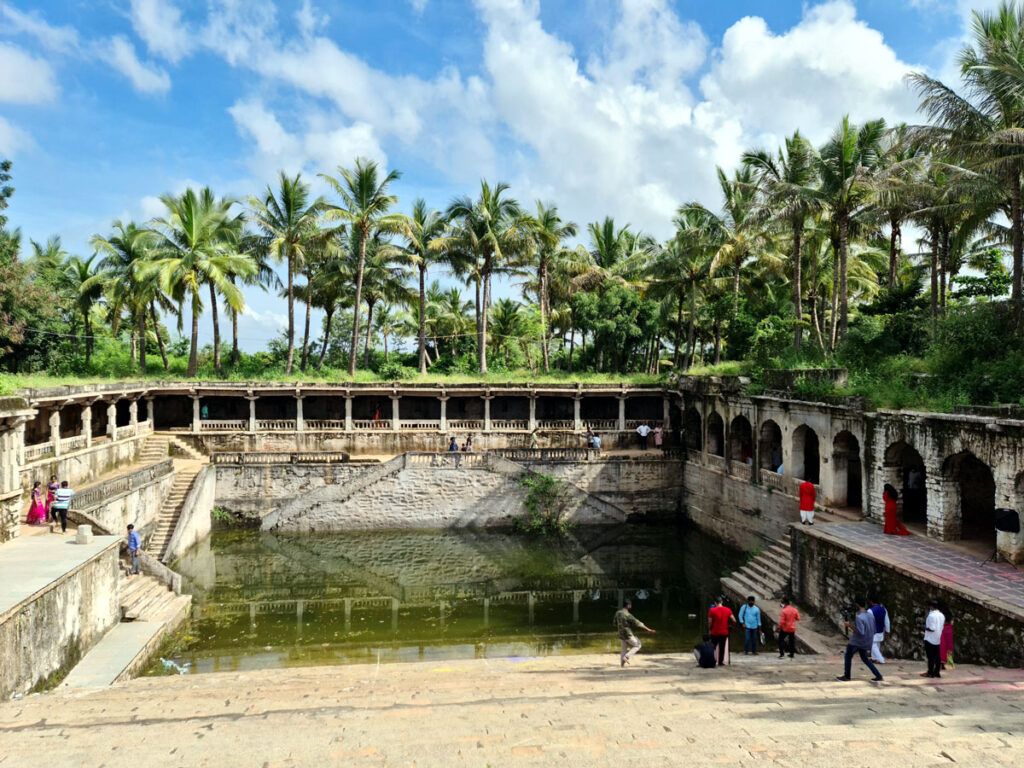
Ammapalli Temple Timing and Rituals:
Timings:
- Opening: 5:00 AM
- Closing: 9:00 PM
- Darshan Timings:
- Morning: 5:30 AM to 12:00 PM
- Evening: 5:00 PM to 8:30 PM
Special Timings:
- Abhishekam: 6:00 AM (Monday, Wednesday, Friday)
- Kalasabha Puja: 9:00 AM (Tuesday, Thursday, Saturday)
- Seva: 10:00 AM to 12:00 PM (all days)
- Deeparadhana: 6:00 PM (all days)
Rituals:
- Darshan: The main ritual is to have a darshan of the deity. This involves standing in line and seeing the deity for a few seconds.
- Abhishekam: This is a special ritual in which the deity is bathed with milk, ghee, panchamrita, and other sacred substances.
- Kalasabha Puja: This is a major puja that is performed once a year. It involves chanting mantras and offering prayers to the deity.
- Seva: This is a voluntary service that devotees can perform at the temple. This can include cleaning the Ammapalli temple, preparing food for the deity, or helping with other tasks.
- Deeparadhana: This is a ritual of lighting lamps in front of the deity. It is usually performed in the evening.
Festivals of Ammapalli Temple:
Ammapalli Temple, dedicated to Lord Vishnu, celebrates several vibrant festivals throughout the year, each with its own unique traditions and significance. Here are some of the most notable ones:
1. Vasant Utsavam (Spring Festival):
- Held in February or March, marking the arrival of spring.
- Decorated temple premises with vibrant floral arrangements and colorful kolams (floor Rangoli).
- Special pujas and rituals performed for Lord Vishnu, seeking blessings for a bountiful harvest and prosperity.
2. Sri Ramanavami (Birth of Lord Rama):
- Celebrated in April, commemorating the birth of Lord Rama, an incarnation of Vishnu.
- Special abhisheka (ritual bathing) of the Lord Rama idol with milk, honey, and other sacred substances.
- Chanting of devotional hymns and processions through the temple grounds.
3. Pavitrotsavam (Temple Purification Ceremony):
- Usually held in April or May, marking the annual cleansing and purification of the temple.
- Traditional rituals are performed by priests to remove any negative energies and ensure the sanctity of the Ammapalli temple.
- Followed by a grand procession of the temple deities, accompanied by music and dance.
4. Garuda Jayanti (Birth of Lord Vishnu’s Eagle Mount):
- Celebrated in July or August, honoring Garuda, the majestic eagle vehicle of Lord Vishnu.
- Special prayers and offerings made to Garuda seeking his blessings for protection and good fortune.
- Cultural performances and traditional Garuda Vahana processions showcasing the mythical bird.
5. Krishna Janmashtami (Birth of Lord Krishna):
- Celebrated in August or September, commemorating the birth of Lord Krishna, another incarnation of Vishnu.
- Devotional hymns, dance performances, and cultural programs depicting Krishna’s life and teachings.
- Dahi Handi (pot-breaking) ceremony, where participants climb a human pyramid to break a pot of yogurt suspended high above.
6. Dussehra (Victory of Good over Evil):
- Celebrated in October, marking the triumph of good over evil, symbolized by the victory of Lord Rama over the demon king Ravana.
- Special pujas and rituals performed for Lord Rama and Sita.
- Large effigies of Ravana are burnt, signifying the destruction of negativity.
7. Deepavali (Festival of Lights):
- Celebrated in October or November, illuminating homes and temples with diyas (clay lamps) and rangoli.
- Special pujas and offerings made to Lakshmi, the goddess of wealth and prosperity.
- Fireworks displays and exchange of sweets and gifts mark the festivities.
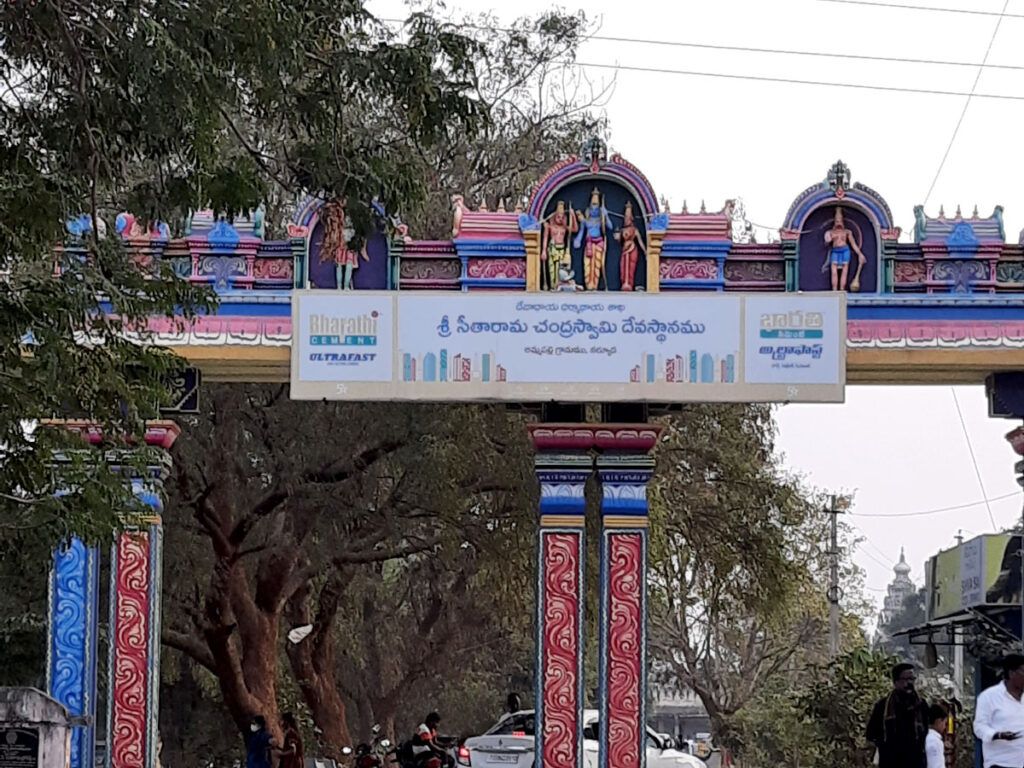
Places to visit near Ammapalli Temple:
- Bhadrachalam:
- Distance from Ammapally: Approximately 150 km
- Bhadrachalam, situated on the banks of the Godavari River, is famous for the Bhadrachalam Temple dedicated to Lord Rama. The temple is known for its beautiful architecture and is an important pilgrimage site.
- Kaleshwaram:
- Distance from Ammapally: Approximately 170 km
- Kaleshwaram is a significant pilgrimage site where the rivers Godavari and Pranahita merge. The Kaleshwara Mukteswara Swamy Temple is one of the major attractions here.
- Basar:
- Distance from Ammapally: Approximately 180 km
- Basar is known for the Gnana Saraswati Temple, a popular shrine dedicated to the goddess of knowledge. The temple is situated on the banks of the River Godavari.
- Medak:
- Distance from Ammapally: Approximately 100 km
- Medak is known for the historic Medak Cathedral, a beautiful church built in the Gothic Revival style. The Medak Fort and Pocharam Wildlife Sanctuary are other attractions in the vicinity.
- Hyderabad:
- Distance from Ammapally: Approximately 35 km
- The capital city of Telangana, Hyderabad, offers a variety of attractions, including the Charminar, Golconda Fort, Qutub Shahi Tombs, and the vibrant markets of Laad Bazaar and Moazzam Jahi Market.
- Yadagirigutta:
- Distance from Ammapally: Approximately 60 km
- Yadagirigutta is known for the Yadadri Lakshmi Narasimha Swamy Temple, dedicated to Lord Narasimha. The temple is located on a hillock and is a popular pilgrimage destination.
- Nagarjuna Sagar:
- Distance from Ammapally: Approximately 180 km
- Nagarjuna Sagar is famous for the Nagarjuna Sagar Dam, one of the largest dams in India. The area also has the Nagarjuna Konda Museum, showcasing the rich history of the region.
Ammapalli Temple Wedding Cost:
The wedding cost at Ammapalli Temple can vary depending on several factors, including the date, the number of guests, and the specific services you choose. However, here’s a general breakdown of the costs you can expect:
Temple Hall:
- Booking Fee: This is a non-refundable fee to reserve the temple hall for your wedding. The current booking fee is Rs. 11,000.
Additional Fees:
- Dharmicar Fees: These are fees paid to the temple priests for performing the wedding ceremony. The amount can vary, but it typically starts around Rs. 5,000.
- Pooja Materials: You will need to purchase various puja materials, such as flowers, fruits, and coconuts. The cost of these materials can vary depending on your preferences.
- Mandap Decoration: You can choose to have the mandap (wedding altar) decorated by the temple or hire an outside vendor. The cost of decoration will vary depending on the complexity of the design.
- Catering: You can arrange for catering services through the temple or hire an outside caterer. The cost of catering will depend on the number of guests and the menu you choose.
Other Expenses:
- Photography and Videography: You can hire photographers and videographers to capture your wedding.
- Music and Entertainment: You can hire musicians or other entertainers to perform at your wedding.
- Wedding Dress and Jewelry: You will need to purchase or rent a wedding dress and jewelry.
Total Cost:
The total cost of a wedding at Ammapalli Temple can range from Rs. 25,000 to Rs. 1 lakh or more, depending on the factors mentioned above.
Here are some tips for saving money on your Ammapalli Temple wedding:
- Book your wedding in advance: This will help you get the best rates on the temple hall and other services.
- Set a budget: Decide how much you are willing to spend on your wedding and stick to your budget.
- Shop around: Get quotes from different vendors before making any decisions.
- Do some things yourself: If you are handy, you can do some of the wedding preparations yourself, such as decorating the mandap or making your own wedding favors.
Ammapalli Temple FAQ:
History and Architecture:
- When was it built? The temple is believed to have been built in the 12th century AD by the Eastern Chalukya dynasty.
- What architectural style is it? It blends the Vesara and Dravida styles, resulting in a unique and impressive structure.
- What are some notable features? The seven-story gopuram (gateway tower) is 90 feet tall and features intricate carvings of Vishnu, Rama, and other deities. There are also two large temple tanks and a serene mandapa opposite the temple.
Deities and Significance:
- Who is the main deity? The Ammapalli temple is dedicated to Lord Rama, Sita, and Lakshmana, carved from a single black stone.
- What is the religious significance? It is considered a powerful temple for blessings related to marriage, childbirth, and prosperity.
- Is there an idol of Hanuman? Interestingly, Hanuman is not present in the garbhagriha. Legend says Rama and Lakshmana reached this place before meeting Hanuman.
Visiting the Temple:
- What are the opening and closing times? The temple is open from 5:00 AM to 7:00 PM.
- What are the best days to visit? Rama Navami in April is a particularly special time to visit, but the temple is popular throughout the year.
- What are the dress codes? Modest clothing is required. Men should wear shirts and pants, and women should wear skirts or dresses that cover their knees.
How to reach Ammapalli Temple:
By Air:
The nearest major airport is Rajiv Gandhi International Airport (HYD) in Hyderabad, which is approximately 65-70 kilometers away from Ammapally. From the airport, you can hire a taxi or use other transportation options to reach Ammapally.
By Train:
The nearest railway station is likely to be the Secunderabad Railway Station in Hyderabad. From the railway station, you can hire a taxi or take a bus to reach Ammapally. The distance by road would be approximately 60-65 kilometers.
By Road:
- From Hyderabad: Ammapally is accessible by road from Hyderabad. You can drive or hire a taxi to reach the Ammapalli temple. The journey may take around 1.5 to 2 hours, depending on the traffic conditions.
- Public Transportation: You can also use state-run buses or private buses from Hyderabad to reach nearby towns or villages, and then take local transportation to Ammapally.
Local Transportation:
Once you reach the general vicinity of Ammapally, you may need local transportation like auto-rickshaws or taxis to reach the Sri Seetha Rama Chandra Swamy Temple.
Temple Address:
Sri Seetha Rama Chandra Swamy Temple, Ammapally Village, Near Shamshabad, Ranga Reddy District, Telangana, India.
